Elephants: India
This is a collection of articles archived for the excellence of their content. |
2013-15: Slaughter in the south

The Times of India, Aug 13 2015
100 elephants killed in 2 years across south
Viju B & Oppili
Worst jumbo carnage since Veerappan run
Kunjumon has lived most of his adult life in the forests of Kerala -as a government watchman and then as a cook for poachers.That transition made little difference, he told cops. It was the killing of a baby elephant in 2014 that changed his life.In June 2015, the 62-yearold walked into a forest office and made his peace.
What emerged in the probe was a massive poaching operation for tusks (ivory) in not just Kerala, but neighbouring Tamil Nadu and Karnataka as well. Investigators in Kerala found that the gang had killed more than 20 elephants in 10 months, but forest officials told that the toll in the southern region in the past two years could be as high as 100. And this would be the gravest of periods for elephants in the south after forest brigand Veerappan was gunned down in 2004.
Investigations in the past two months point to a nexus of poachers and forest officers.Among the 40 people arrested so far is a forest range officer and a deputy range officer.They also found poachers' dens in the Vazhachal forest and at least 17 crude guns.“The officials would open the check posts for the poachers to cart away the ivory once the elephants were killed,“ said a senior vigilance official with the forest department.
In Tamil Nadu, officials found rampant poaching in Sathyamangalam and Mudumalai tiger reserves, and Bandipur in Karnataka. The mastermind, Aikaramatton Vasu, was found dead in a farmhouse in Dodamarg in Maharashtra. There was a suicide note as well.
Uttarakhand
Corbett and 11 other divisions
The Times of India, Aug 23 2015
Seema Sharma
1,035 elephants rule tiger bastion Corbett
For those who equated Corbett with just tigers, think again. As per the recent elephant estimation exercise conducted in Uttarakhand in June, Corbett Tiger Reserve (CTR) has emerged as one of the main bastions of elephants with the presence of as many as 1,035 pachyderms being recorded in the reserve. According to the estimation exercise, the state has a total of 1,797 elephants which is an increase of 15% over the last estimate carried out in 2012, when 1,559 elephants were recorded. It is also a rise of almost 33% over the last census of 2007 when 1,346 elephants were counted.
Elaborating on the methodology used for the estimation exercise, Dinesh Aggarwal, state forest minister, told TOI, “The estimation was conducted in CTR, Rajaji Tiger Reserve and 11 territorial divisions of Shivalik, Eastern & Northern Kumaon and Bhagirathi circles covering an area of 6643.5 sq km. Methodology was based on direct synchronized counts and detailed information about each elephant sighting. about each elephant sighting.GPS coordinates were recorded and reviewed and collated at the Wildlife Institute of India.“
The steady increase in jumbo numbers comes after a 50% increase registered in tiger sightings in Corbett. Dhananjay Mohan, who headed the exercise, told TOI, “Our effort to improve the habitat conditions in Corbett has paid off. Special efforts were made to remove weeds and lantana, which helped in expanding the feeding ground for elephants.“ Another reason, according to Anil Dutt, principal chief conservator of forests (wildlife), is that Corbett has the Ramganga river, a perennial source of water, because of which the ranges situated close to it, like Dhikala and Sarpduli accounted for 242 and 193 jumbos respectively .